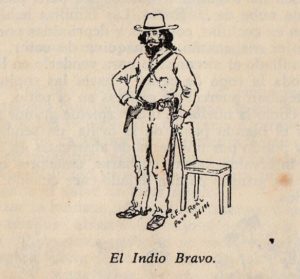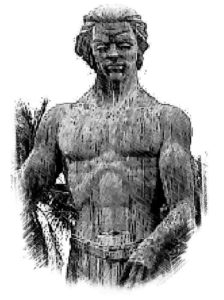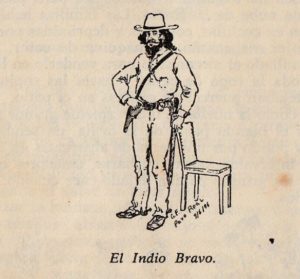 LA LEGENDARIA HISTORIA DEL ‘INDIO BRAVO’ CAMAGUEYANO.
LA LEGENDARIA HISTORIA DEL ‘INDIO BRAVO’ CAMAGUEYANO.
Cuando se habla de bandoleros famosos en Cuba, vienen a la mente, de golpe, los nombres de Manuel García y de Arroyito, pero casi nadie recuerda a El Indio Bravo que sembró el terror en la jurisdicción de Puerto Príncipe (Camagüey) a comienzos del siglo XIX.
Nunca llegó saberse cómo se llamaba en verdad. Los que lo vieron aludían a su corpulencia, su fuerza descomunal, su crueldad primitiva. Se dice que montaba al pelo un caballo negro enorme y que, aunque iba armado de trabuco, machete y cuchillo, era, sobre todo, diestro en el manejo del arco y de la flecha y dejaba a su paso una estela de vacas a las que había arrancado la lengua.
El Indio Bravo fue un bandolero singular. No era un simple ladrón de fincas o un salteador de caminos. Tampoco hay constancia de que descendiera en verdad de los primitivos habitantes de la Isla.
Si sacrificaba aquellas bestias es porque la lengua asada era su alimento preferido y cuando recurrió a los secuestros fue siempre para exigir comida a cambio. Pero en aquella ciudad pequeña que era el Camagüey de entonces pronto los rumores subieron de tono y de boca en boca El Indio Bravo se vio convertido en un caníbal que se robaba a los niños para alimentarse con ellos o simplemente para arrancarles el corazón y beber de su sangre.
..Es explicable entonces que los rumores se propalaran con mucha facilidad y se les dieran más crédito a medida que fuesen más absurdos. Por otra parte, se hacía habitual que la atmósfera cerrada y extremadamente represiva de la colonia provocara hechos brutales.
Siguió la vida su monótono transcurrir. En 1801, cuando el bandolero llevaba en lo suyo alrededor de un año, el ayuntamiento principeño prometió recompensar al que lo capturara con 500 pesos, suma elevadísima para la época.
Nada se consiguió, sin embargo. No se le atrapó entonces ni tampoco en los años subsiguientes. Llegó así el de 1804 y el Cabildo aprobó un plan para la captura del Indio. A partir de ahí se inició la cuenta regresiva para el Indio Bravo.
Más que el ofrecimiento de la jugosa recompensa, que el ayuntamiento mantenía en pie, fue el secuestro del niño José María Álvarez González, hijo de un vecino principal de la villa, lo que apresuró y concentró las acciones de su búsqueda y captura. Muchos principiemos se sumaron a ellas con el fin de evitar, decían, que el tierno infante fuese devorado por el malhechor.
El 11 de junio de 1804 le llegó la mala hora al indio Bravo. Dos vecinos de la finca Cabeza de Vaca, lo capturaron y ajusticiaron. Se ha dicho que fue un esclavo quien en realidad dio muerte al delincuente, pero que por su condición de esclavo no tuvo parte en la recompensa pecuniaria. La injusticia quedó intacta.
Al filo de la media noche de ese día el Indio Bravo entró por última vez a Camagüey. En la Plaza de Armas se expuso su cadáver a la curiosidad y al escarnio. Pese a lo intempestivo de la hora las iglesias echaron sus campanas al vuelo y los templos se abarrotaron de fieles que agradecían haber sido librados de aquel azote real, pero que en buena parte inventaron. Al día siguiente el pueblo se lanzó a la calle lleno de alegría para celebrar el San Juan tradicional con júbilo desconocido hasta entonces.
Pasó el tiempo. El Indio Bravo no cayó en el olvido. Su condición de rebelde solitario se asoció, 90 años después de su muerte, con el enfrentamiento de los camagüeyanos al colonialismo español.
En 1893 un periódico independentista que circulaba clandestinamente llevó su nombre, como si el Indio Bravo quisiera vengarse de una vez por todas de sus matadores.
 THE LEGENDARY STORY OF THE ‘INDIO BRAVO’ CAMAGUEYANO.
THE LEGENDARY STORY OF THE ‘INDIO BRAVO’ CAMAGUEYANO.
When talking about famous bandits in Cuba, the names of Manuel García and Arroyito suddenly come to mind, but almost nobody remembers El Indio Bravo who sowed terror in the jurisdiction of Port-au-Prince (Camagüey) at the beginning of the XIX century.
It never came to be known what it was really called. Those who saw him alluded to his corpulence, his enormous strength, his primitive cruelty. It is said that he was riding a huge black horse and that, although he was armed with a trabuco, machete, and knife, he was, above all, skilled in the handling of the bow and arrow and left in his wake a trail of cows to which He had torn his tongue.
The Indian Bravo was a singular bandit. He was not a simple farm robber or a highwayman. Nor is there any evidence that he actually descended from the primitive inhabitants of the Island.
If he sacrificed those beasts it is because the roasted tongue was his favorite food and when he turned to kidnappings it was always to demand food in return. But in that small city that was the Camagüey of then soon, the rumors rose in tone and from mouth to mouth. The Indian Bravo was turned into a cannibal who stole the children to feed them or simply to tear their hearts and drink from his blood.
.. It is explainable then that the rumors spread very easily and were given more credit as they became more absurd. On the other hand, it was customary for the colony and extremely repressive atmosphere of the colony to cause brutal acts.
He continued his monotonous life to pass. In 1801, when the bandit had been around for a year, the princely town hall promised to reward the one who captured him with 500 pesos, a very high sum for the time.
Nothing was achieved, however. He was not caught then, nor in subsequent years. One of 1804 arrived and the Cabildo approved a plan for the capture of the Indian. From there the countdown to the Indian Bravo began.
More than the offer of the juicy reward, which the city council kept standing, it was the kidnapping of the child José María Álvarez González, son of a main neighbor of the town, which hastened and concentrated the actions of his search and capture. Many beginners joined them in order to avoid, they said, that the tender infant was devoured by the evildoer.
On June 11, 1804, the bad time came to the Indian Bravo. Two neighbors of the Cabeza de Vaca estate, captured and executed him. It has been said that it was a slave who actually killed the offender, but because of his status as a slave, he had no part in the pecuniary reward. The injustice was intact.
At the edge of the midnight of that day the Bravo Indian last entered Camaguey. In the Plaza de Armas, his body was exposed to curiosity and derision. In spite of the untimely hour, the churches threw their bells on the flight and the temples were filled with faithful who were grateful to have been freed from that royal scourge, but which they largely invented. The next day the town threw themselves into the street full of joy to celebrate the traditional San Juan with joy unknown until then.
Time passed. The Indian Bravo did not fall into oblivion. His condition as a solitary rebel was associated, 90 years after his death, with the confrontation of the Camagüeyanos to Spanish colonialism.
In 1893 an independentist newspaper that circulated clandestinely bore his name as if the Indian Bravo wanted to take revenge once and for all of his killers.
Agencies/ RHC/ Ciro Bianchi/ Extractos/ Excerpts/ Internet Photos/ Arnoldo Varona/ www.TheCubanHistory.com
THE CUBAN HISTORY, HOLLYWOOD.








